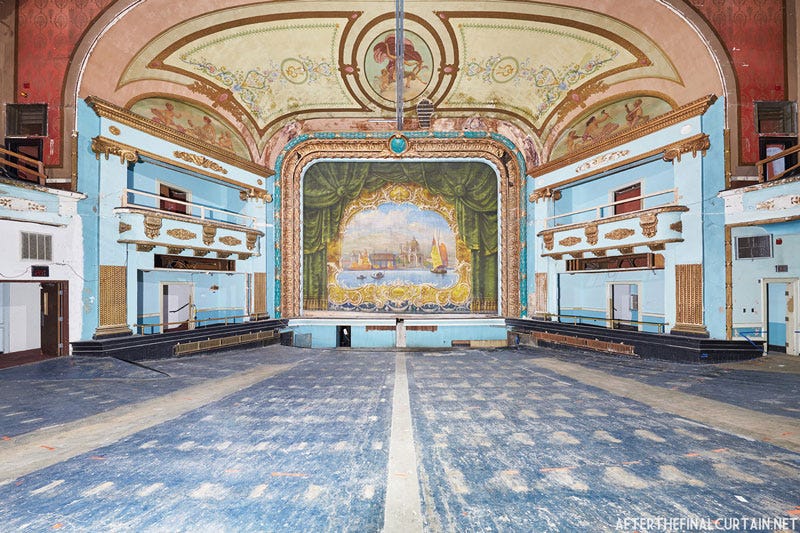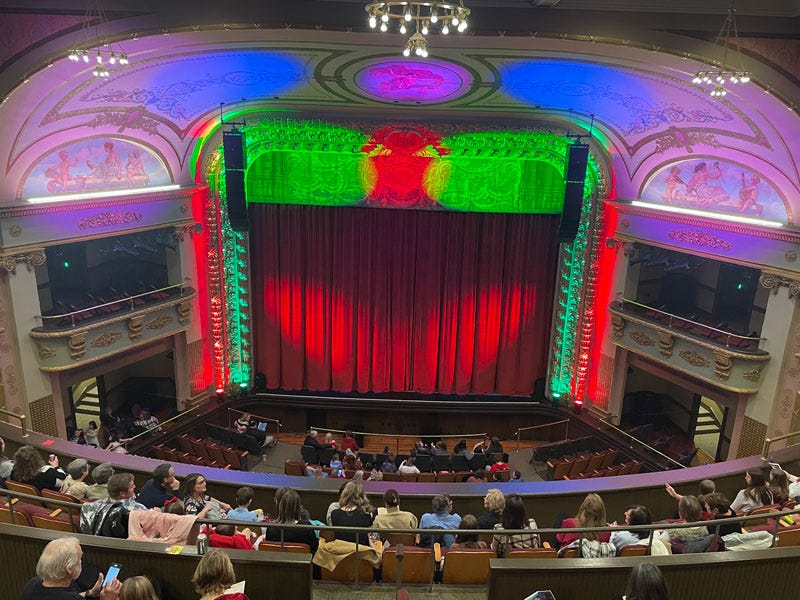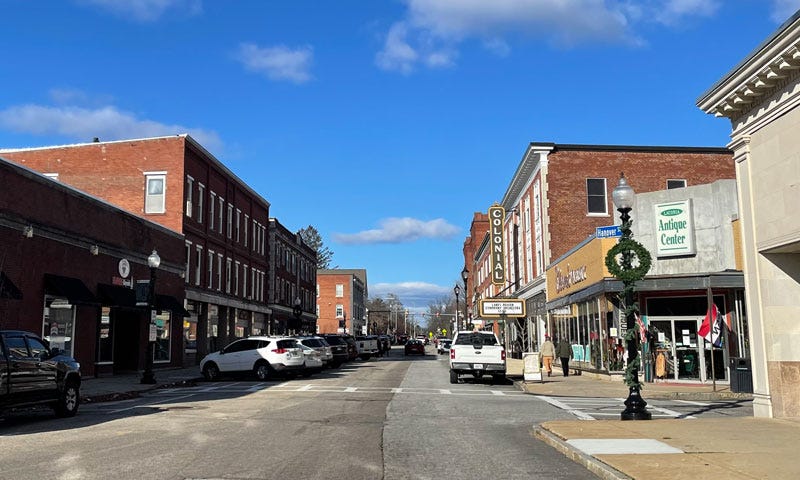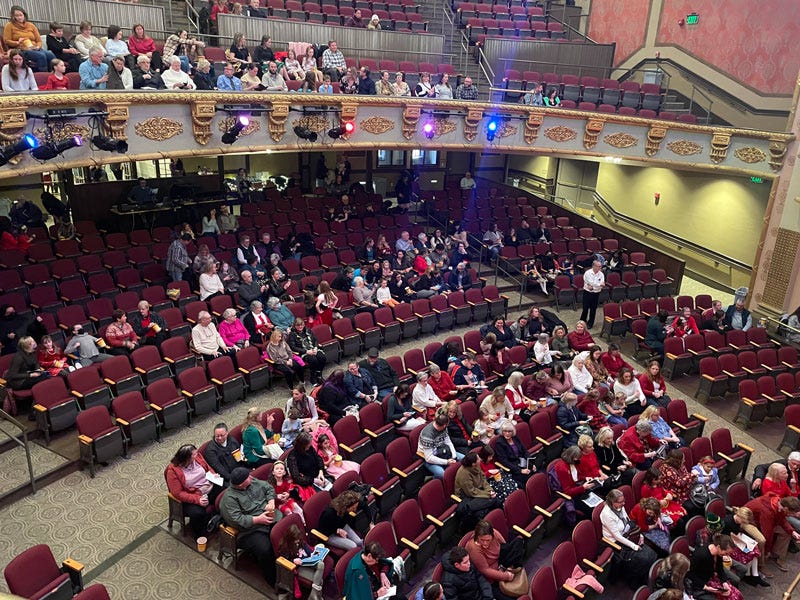Restoring Local Theatre
The story of Laconia's Colonial Theatre and the role of the arts in our communities
Welcome to the Quarantine Creatives newsletter, a companion to my podcast of the same name, which explores creativity, art, and big ideas as we continue to live through this pandemic.
If you like what you’re reading, you can subscribe for free to have this newsletter delivered to your inbox on Wednesdays and Sundays:
There’s nothing quite like the excitement of live theatre, although it can sometimes be challenging to prioritize getting out with two kids and a busy life.
This fall, I wrote about visiting Laconia, New Hampshire and falling in love with its Main Street. On that visit, the glowing marquee of the Colonial Theatre tempted us to stop inside, but we didn’t end up having the time.
About two weeks ago, we ended up returning to the Colonial Theatre to see a performance of The Nutcracker put on by Safe Haven Ballet, a group which I hope to cover at length in a future installment of this newsletter.
Today, I wanted to take a photo tour of the newly restored Colonial Theatre, plus share some insights on the process of reviving a community through the arts.
The Colonial Theatre was originally built in 1914 and it has lived quite the life over the last 100 or so years. In some ways, the story of the Colonial is the story of live entertainment, the story of cinema, and the story of our small towns all wrapped into one.
Peter Lally is the president of Spectacle Live, the company which manages the Colonial Theatre and several similar sized venues throughout New England. He helped me understand some of the history of the theatre:
“When that theater was first opened, it was mostly vaudeville performances, and as time went on, was home to all kinds of different theatrical and musical touring groups. As movies came about, that came into the mix with it being a single-screen movie theater.”
In the late 1970s or early 1980s, the theatre was hastily turned into a five screen multiplex. The upstairs balcony housed two screens, the orchestra had another two screens, and the stage area was converted to a screen too. According to Lally, this was unfortunate, but it may have also helped save the theatre:
“Those decades of the the seventies and eighties where the live touring industry, for whatever reason, wasn't economically viable for a space like that and they turned to movies to make it through, a lot of [the theatres] that didn't do that got torn down.”
The Colonial survived, but it hardly thrived. For the last twenty years, it was privately owned, poorly maintained, and vacant.

A partnership between Belknap Economic Development Council, the City of Laconia, developer Rusty McLear, and many local partners helped bring about the revival of the Colonial Theatre. According to Justin Slattery, executive director of Belknap Economic Development Council, the renovation cost $14.7 million and the updated 750 seat venue debuted in the summer of 2021.
The theatre today feels comfortable and modern, while still retaining many of the classic features. There are beautiful murals painted above the stage, ornate detail work on the balconies and boxes, and period light fixtures overhead.
Slattery described to me the extent of the work:
“In reality we rebuilt it. We kept the artwork and the fixtures, and so forth, but it really was gutted and rebuilt with modern technology, HVAC systems, and theater equipment and technology.”
The theatre feels grand, almost like a 3/4 scale Broadway venue, but the vibe is still very community focused.
At the show we attended, there were a handful of ushers there to help us find our seats, but they weren’t overly aggressive. Before the show, I wandered around the entire theatre (including the box seats) to admire the restoration work and take photos, and never once was I made to feel unwelcome or that I was in the wrong area. I have a hard time imagining that kind of reception at a larger venue.
The newly installed seats were comfortable and spacious, with plenty of legroom, which can often be a rarity in older theaters. This was a theatre where you were encouraged to feel at home. At this particular performance of The Nutcracker, photography was not only permitted but encouraged.
After the show, the performers all came out into the house to greet the audience and answer questions. The lead dancers even hosted a meet and greet on stage, allowing for photos.
In the end, visiting the Colonial Theatre was an interesting hybrid between going to see a professional show and a local production. There was enough spectacle and polish to feel above the everyday, but the theatre was also accessible enough to feel attainable. I could imagine it lighting a spark in my children to perhaps be a dancer, an actor, or a stagehand in a concrete way, where as going to a larger venue may feel more abstract.
Changes to the economics of the music business may have helped the resurgence of midsize venues like the Colonial. Streaming is often seen as eliminating or greatly reducing a revenue stream from artists and performers. Lally views it as a promotional tool similar to social media, that can help smaller artists establish a loyal fan base that will then pay to see acts in person, which can be more profitable:
“Music consumption digitally has opened up a lot more niche audiences for smaller venues. It's one thing to be a superstar in a in an arena or a stadium. But, you know, I think what's quietly developed over the years is just the ability for more artists that are playing in the club level through the kind of small and mid-size performing arts center level to make a living doing that. You know, it doesn't require them to be on FM radio regularly to develop an audience when they can reach people with their music streaming on streaming services.”
While streaming music may be an unexpected opportunity for musicians, ironically streaming movies have negatively impacted theatres that only screen films. Venues like the Colonial that are adaptable have a better chance of surviving. They can attract well known names in music and comedy like Lewis Black, but there are also local acts that make their home at the Colonial, according to Lally:
“There's the Powerhouse Theatre Company, which is our resident theater company. They do six productions a year of at least three performances each. There's also the Putnam Fund, which brings in free concerts entertainment about six to eight times a year as well. Last year, we probably brought in another 25 or 30 concerts and shows. Then other types of events, whether it be the high school has their concert there, the Lakes Region Symphony is in there, Safe Haven Ballet, so it's been a pretty busy spot.”
From the standpoint of Main Street, the Colonial Theatre has become an anchor to an already active downtown area. According to Lally, this was all by design:
“Ed Engler, who was a long time mayor in Laconia, really felt, and I think rightly so, that the fate of the Colonial would be reflective of the fate of downtown Laconia. In other words, with that centerpiece of downtown being closed and dormant it was never going to be a place where other people wanted to take chances on opening businesses and and having a a vibrant main street.”
The Colonial Theatre is a mixed use development. The building that faces the street has retail space on the sidewalk with apartments above. The theatre itself sits behind that. Both structures were renovated as part of the redevelopment, and having several different uses keeps people in the area even when there’s not a show.
Much like a department store serves as an anchor at a shopping mall, attracting traffic to the smaller shops nearby, theatres in a city environment serve as an anchor for Main Street. When they are thriving and their marquee lights sparkle, they bring the entire shopping district alive and can a positive impact on the entire neighborhood. When they are neglected, in disrepair, or vacant, they can discourage investment and keep people away from the streets.
The revival of the theatre brings a new life to Main Street. For towns that have a similar vacant property that they hope to revive, Lally explains what it takes:
“Three times the money, and twice the time that they think of initially.”
Just as the restoration work involved carpenters, plasters, electricians, decorative painters, and theatre technology trades, the ownership and operation of the theatre also involves several interwoven and cooperative groups, as Slattery from Belknap Economic Development Council explained to me:
“The city is our our tenant. We have a lot of funding involved, a lot of different various fund tax credits, and so forth. And so we own the building and we lease it to the city of Laconia, who then has a contract with a a professional theatre management company called Spectacle Live.”
It took a lot of people from the public and private sector working together to bring Laconia’s Colonial Theatre back to life. It’s only been one year, but hopefully this investment will prove to be worth the time and money invested, and may serve as a blueprint for other communities looking to revitalize their own Main Streets.
What are your thoughts? I’d love to hear from you in the comments.
Related Reading
If you’d like to catch up on past episodes of the Quarantine Creatives podcast, they can be found on Apple Podcasts, Spotify, or wherever you listen.
If you’ve missed past issues of this newsletter, they are available to read here.
Stay Safe!
Heath













Absolutely love that The Colonial is doing well and such a center focus of Main Street, Laconia - the inside of the theatre looks amazing and so cool that the community supports it. Though not on the scale of The Colonial, I'm hoping The Strand in Clinton could have some kind of turnaround of this nature. It did well as a single theatre that also served drinks and food, and seemed to have a solid niche as that, but you can tell this is a theatre that had its beginnings at a similar time as The Colonial. Not as ornate or big, but a nice performance theatre for the community. It closed the end of 2021 (one of its two owners was the incredible director of years of musicals at Nashoba High School). It's surrounded by Worcester and Boston of course, so public performances as tough to support the theatre, but something maybe... With the Worcester-area Renaissance, Clinton itself on the upswing, who knows.